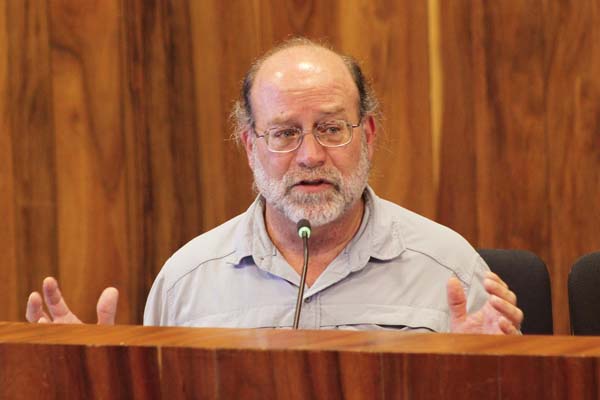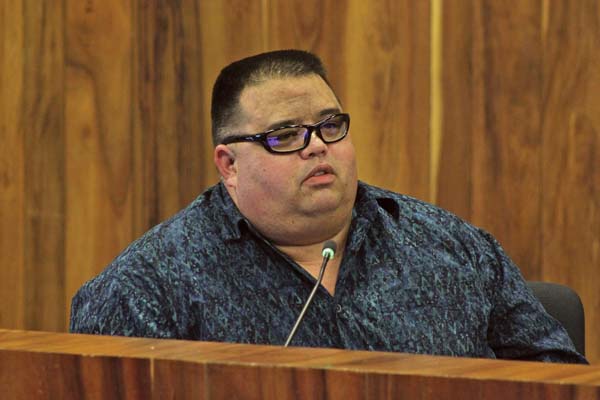
WAILUKU — Sunscreen containing certain chemicals could be banned in Maui County after a bill to eliminate the potentially harmful products was recommended for approval by a Maui County Council committee Monday.
The bill, which is headed for the full council, would prohibit the sale and use of sunscreen carrying oxybenzone and octinoxate, ingredients that have grown controversial over the past few years.
“I think it’s really about time,” council Vice Chairman Bob Carroll said. “It’s something that we need to have done and the sooner we do have this in effect, it gives our ocean and our fish and our limu a chance to recover and prosper.”
During the recent state legislative session, Ewa Beach Sen. Will Espero introduced a measure that would have banned products with the same chemicals. However, Senate Bill 1150 stalled in conference committee.
If passed, Maui County’s ban would be the first in the country, said Joe DiNardo, a retired scientist and toxicologist from Virginia who gave a presentation to the Infrastructure and Environmental Management Committee on Monday.

Oxybenzone and octinoxate can be found in a range of materials, from plastic bottles to printing inks, and are popular in the manufacture of sunscreen.
“They are broad-spectrum UV absorbents,” said Craig Downs, a Kapalua native who’s now the executive director of the nonprofit Haereticus Environmental Laboratory in Virginia. “That’s really important to help prevent sunburns. So they do play a critical role. . . . But they’re not the only two chemicals that can be used in a product to protect you from sunburns.”
Supporters of a ban believe it would help protect coral reefs; opponents contend that the ingredients are safe for use, pointing out that oxybenzone has been approved by the Food and Drug Administration. But that was back in 1978, when the bar for testing sunscreens was lower, DiNardo said.
Downs said that the two chemicals can lower the resiliency of coral reefs to bleaching. They can affect the development and endocrine systems of fish. And, the risk of spreading the chemicals in the ocean is not only when sunscreen-wearing swimmers are in the water, but also when they go home and use the shower or the toilet.
Samples of swimming and snorkeling spots around Maui have found growing levels of oxybenzone and octinoxate in the water, Downs said. Oxybenzone is toxic to corals at 62 to 280 parts per trillion. Three locations in South Maui had levels ranging from 340 to 1,096 ppt. Seven West Maui locations ranged from 125 to 4,252 ppt, which was at Black Rock in Kaanapali.
Octinoxate, meanwhile, is toxic at 105 to 220 ppt. The same seven locations in West Maui ranged from 69 to 967, while the three South Maui spots ranged from 33 to 1,516 ppt.
While many factors can cause coral bleaching, including warmer ocean temperatures, Downs said sunscreens can also play a role. Corals exposed to oxybenzone and octinoxate in both the ocean and the lab have shown signs of bleaching, even in temperatures “nowhere near” the typical bleaching threshold of 88 degrees Fahrenheit, Downs said.
Sunscreen can also help prevent sunburn and decrease the risk of skin cancer, but “the bottom line is sunscreens do not prevent skin cancer,” said DiNardo, adding that scientists view protective clothing and staying out of the sun as the key.
“Sunscreens are important,” DiNardo said. “We still need to use them. But they are not the end-all and be-all to anything associated with skin cancer.”
The eight testifiers Monday mostly voiced support for the ban. Residents whose families fish and farm talked about the noticeable decline of reefs and the concern that sunscreen could also find its way into freshwater ponds and taro patches. Testifiers believed beachgoers would be open to making the change, as well as businesses wanting to earn a reputation as environmentally friendly.
“Unlike banning smoking where people are addicted to smoking . . . there’s no stress involved in switching to a healthier product,” said Susan Varsames, creator of Mama Kuleana sunscreen, which uses zinc oxide. “There’s no financial burden. . . . This is a really easy learning curve for people because it’s a win-win.”
Rob Parsons, county environmental coordinator, said that Mayor Alan Arakawa hasn’t expressed a position for or against, but said that the mayor is concerned about the challenge of enforcing such a ban. However, Parsons agreed with other testifiers who said installing a ban, like putting up a speed limit sign, could help deter the use of harmful sunscreens.
Council members were supportive of the bill, though they were concerned about the measure being legally sound. Deputy Corporation Counsel Richelle Thompson said that the bill could open the door to challenges based on the federal Commerce Clause, which protects interstate commerce. She also thought the county should first consult with the state Department of Land and Natural Resources, which has jurisdiction over nearshore waters. Unlike the county’s recent ban on polystyrene, a ban on certain sunscreens could cross county and state lines.
Council Member Yuki Lei Sugimura said that the county already has a hard time enforcing rules and thought the council should hear from state and county departments before passing a new law. However, Council Member and Committee Chairwoman Elle Cochran pushed for a vote, saying the scientific evidence was solid and the bill was “defensible.”
* Colleen Uechi can be reached at cuechi@mauinews.com.

Leave a Reply